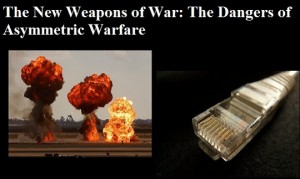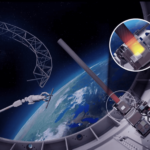March 27, 2014 – It has happened in the immediate present, but the “incursion” by “non-Russian,” invasion forces in Crimea, Ukraine, followed by a hastily organized vote of secession, speaks volumes about warfare’s 21st century face. Today in the era of the “war on terror” we no longer pit armies against armies in front line battlefield confrontations like the ones that characterized past wars.
War today is asymmetric. Victories are had with deft insertions involving a few rather than putting millions in the field. Armed to the teeth with technology and intelligence, soldiers drop from the sky and eliminate enemy targets in a matter of minutes. Even better, robot do the job guided to targets by human operators sitting thousands of kilometers away.
The latest war, Russia’s invasion into Crimea, although more conventional in some respects, is a good example of asymmetric warfare. The confrontations hasn’t involved cannonades or fleets of bombers dropping death from the skies. Instead the war has been surgical in its precision, minimalist, and effective.
So how does one develop a strategy to defeat the asymmetric wars we are seeing in the 21st century? By a combination of tactics and technology.
If we were to deploy the old ways of war we would do one of two things:
- Counter the invasion with an assault force backed by superior firepower and technology to force the enemy out. The downside of this approach would be the time it would take to mount such an invasion, the high incidence of casualties, and the potential escalation of the confrontation to encompass a much larger field of operations.
- Let the enemy completely take over and then when you know exactly where they are, bomb them into submission. With aerial stealth technology you could minimize equipment and operational casualties. You could deploy fleets of drones to do the work of defeating the enemy knowing exactly where he is. But this approach, lie point number one, would have great potential to escalate to a much larger field of operations.
The new way of asymmetric warfare appears today to not involve soldiers and firepower at all. Instead it takes advantage of our global interdependency derived from a highly technology-connected world. It employs economic weapons of mass destruction. An interdependent world has created asymmetric nations that no longer manufacture much of what they consume and instead have become dependents of others for the goods they consume. An interdependent world has resource generating countries dependent on consuming nations to buy what they pull and pump out of the ground.
Interdependency goes beyond goods and services. It takes in the telecommunications cloud that envelops our globe. The evolution of the Internet is the bridge that connects all humanity. And in that it is a perfect weapon for 21st century warfare.
It can disseminate information to counter government messages and policies. It can influence whole populations through the instruments of social media and smart phone technology. It is the technology of the Arab Spring. It is difficult to jam despite herculean efforts by national security organizations to try and do just that. Hackers and cyber warfarers find ways around blockages. Cyber warriors can insert viruses, trojan warriors and worms into the nation’s industrial heart leading to massive operational disruptions. It can drain a nation’s reserves. It can shut down banking systems. It can turn off taps. It is this cyber warfare capability that may prove to be the greatest danger to any nation choosing aggression over conflict resolution in the 21st century.
And finally, one cannot talk about 21st century warfare without mentioning the legacy of nuclear weapons. What humanity has feared most since the dawn of the Atomic Age in 1945 is nuclear holocaust, war between nuclear-powered adversaries that rains destruction on a global scale. In developing nuclear weapons, however, it appears humanity has created the single, greatest deterrent to the conventional war of battlefronts like those we witnessed in the 19th and 20th century. Since the United States dropped two atomic bombs on Japanese cities in August 1945, no nuclear weapons have ever been used in battle. The Armageddon scenario, nuclear winter, has virtually made atomic warfare a non-starter.














I don’t see it as a war with an invasion, as an insurrection followed by an incursion. Don’t forget that Crimea was administered as part of the Russian State until the 50’s, if I have that right. Was the vote legitimate? I would rather it had been under UN auspices and I think the insurrectionists and Putin were remiss on that point. Now it’s a question of whether Russia will ever leave Crimea to its own devices. That and what else does Putin have in mind, particularly on Eastern borders now.
Make that the states lying to the south of Russia and North of Turkey and Iran. If Russia wants to get further involved with Moslem nationalism.
I gather by north of Turkey you mean the Transcaucasus – Armenia, Georgia, and Azerbaijan. Russia has already fought a war with Georgia and supported Azerbaijan in a dispute with Armenia. So I suspect they already have extensive influence in the region without annexing any of it. But should Georgia join NATO as it appears is in the works, I suspect the sparks will fly.
Hi Harlan, Crimea has been part of Great Russia since the time of Catherine the Great when it was seized from the Ottoman Empire. The Muslim Tatars are the legacy of Ottoman times. Even after the USSR incorporated Crimea into the Ukraine in the 1950s, sanctioned by Nikita Kruschev, the military presence of Soviet troops made Crimea Russian in character. The dissolution created the Ukraine as a member of the Commonwealth of Independent States, the successor to the Soviet Union. And Ukraine accepted Russian military presence in Crimea ever since. So Russia hasn’t left Crimea to its own devices even since Ukraine became independent for the first time in its cultural and political history.
The easy pickings for Putin or to the southeast where today Russia has a strong military presence. Even Baikonaur, the Russian space launch site, isn’t in Russia, but in one of the “republics” formed after the Soviet Union’s dissolution. To me, despite the Muslim aspect of these republics, if Russia intends to restore Great Russia, this is the direction it will go.